Reverse Sear Prime Rib
Reverse Sear Prime Rib is the absolute best way to cook this gloriously delicious beef roast, with an evenly warmed interior and a browned flavorful crust. The secret is the reverse sear method, where we cook the beef low and slow, let it rest, then blast it with high heat at the end to brown the exterior. The bonus is that you can then serve it right away, without resting!
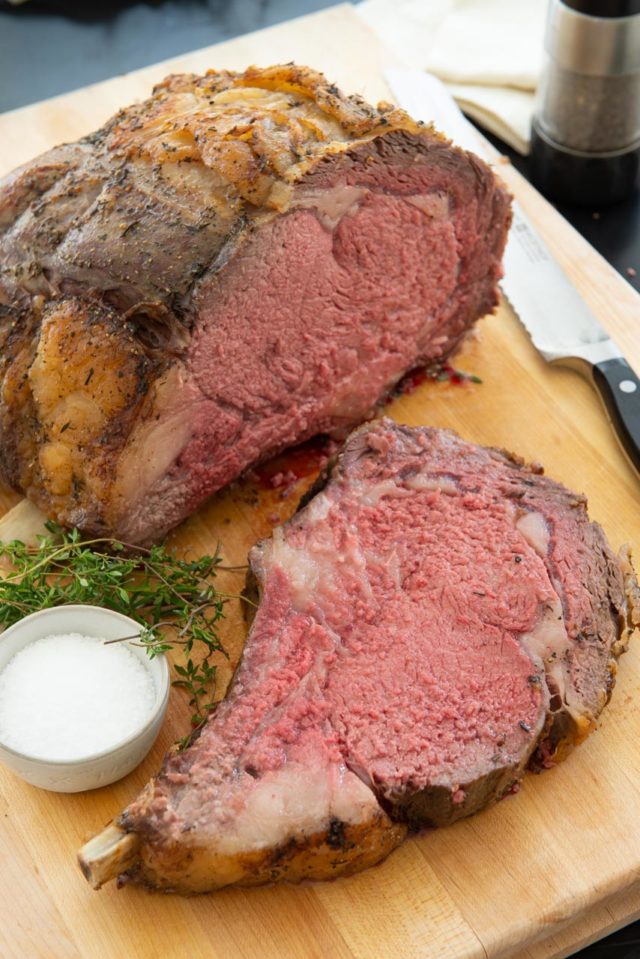
Prime rib is truly one of the best foods that we humans get the privilege to eat. And today’s instructions for how to make it are what I believe to be the best ways to respect this glorious piece of beef, which is so often made for Christmas and other special holidays.
Though I always make Beef Wellington for Christmas dinner, this Reverse Sear Prime Rib recipe is the star of the show for Christmas Eve.
Round it out with some Potato Gratin or Cauliflower Mashed Potatoes for some complimentary creaminess, Maple Glazed Carrots, and a fresh loaf of Asiago Black Pepper Bread, and you’ve got a wildly delicious and satisfying meal.
Most people don’t realize that Prime Rib is the section of beef that a Ribeye Steak is cut from. It’s technically a Prime Rib Roast, and you can imagine it as a bunch of ribeyes side to side.
It’s wonderfully marbled, flavorful, and tender. Ribeye is one of the most preferred cuts of steak there is, so you can only imagine how fantastic this is. There’s a reason it’s a favorite for the holidays, and fortunately, this roast is very simple to prepare.
Why This Recipe Is The Best
Prime rib is such an expensive cut of meat, that you really don’t want to mess it up. If you follow this recipe, you will be rewarded with great results, and the perfect prime rib.
Vigorously tested – I have made prime rib many times, and I eat beef usually twice a day. I’ve have learned a lot from testing out various cooking methods, and in my opinion, this is hands down the best way of cooking prime rib. We will be reverse searing in the oven. All this means is we cook the beef low and slow in the oven for several hours, then rest it, then give it a quick blast of heat at the end.
Perfectly done interior, with no gray ring – If you do a quick search on the web, you’ll see that typically when prime rib is cooked initially with high heat, then lower temperatures afterward, you get a thicker band of grayish brown overdone meat on the edges. Reverse searing minimizes this!
Thoroughly browned, flavorful crust – The high heat at the end makes the fat and exterior caramelize and sizzle. It has so much flavor to give a nice crust for the meat.
No rest needed before serving – Because we rest the beef in between the low and slow cooking and the high heat browning at the end, you don’t have to wait to serve it. You get to enjoy it piping hot and sizzling from the oven.
Completely adjustable for different doneness preferences – I like to enjoy my beef rare, but this recipe can be adjusted for any doneness preference. I share guidelines below.
In this method, we are maximizing internal tenderness and doneness consistency, maximizing external browning, and choosing simple compatible accent flavors that don’t steal the show.
How Much Per Person Is Needed?
I recommend buying 1lb per person. So if you have 10 guests, a 10lb piece should suffice, which is about 4 bones worth. A full section has 7 ribs, about 16 to 18 lbs. I do not recommend attempting to do this recipe with a rib section less than 3 ribs across.
Bone-in or Boneless?
I have made and compared all the options, which one year even included a roast where the butcher had cut the bones away from the meat, but then tied it on to the roast (it was very odd).
Hands down, I prefer to get bone-in prime rib and leave the bones in for cooking, as I believe bone-in cooking maximizes juiciness. If they bother you, you can cut them out before cooking, but you’ll likely need to reduce cooking time slightly for a boneless prime rib roast.
Step by Step Overview:
Here’s a general idea of the process for how to make reverse sear prime rib, and then we’ll get into the detail below.
- Salt the roast 24 hours ahead.
- Rub the outside with black pepper and herbs.
- Cook the beef at 250 degrees F for about 3.5 hours.
- Rest the beef for 30 minutes.
- Brown the beef in a high heat oven for about 5 minutes.
- Serve!
Salt the Meat One Day Ahead, if possible
For best results you’ll want to start a day ahead by salting the roast and letting it sit in the fridge for 24 hours.
Set a wire rack inside a rimmed half sheet pan, and season a 10-lb bone-in standing rib roast with plenty of kosher salt. Rub and press the salt into the meat:
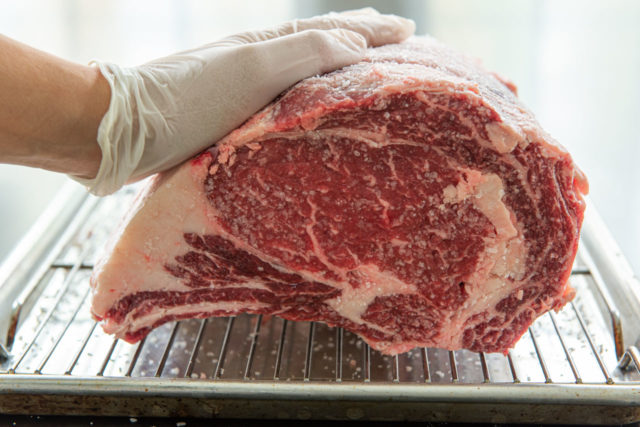
Place this in the refrigerator uncovered for ideally 24 hours, and for a maximum of 48 hours.
Starting A Day Before = More Penetration of Seasoning and Better Browning
The salt will have a chance to penetrate the beef and “season on the inside” to a degree, and it will also pull moisture out. Additionally, by NOT covering the beef in the fridge, this allows the exterior moisture to dry out as much as possible, which encourages browning later on.
What If You Need to Cook This Now?
If you’re coming to this post having already missed this day ahead window, you can still carry out the rest of the cooking method, but it will be slightly inferior. It will still be good though!
Start Warming Up the Beef
Two hours before cooking, remove your bone-in roast from the fridge and let it stand at room temperature. This will give you the juiciest meat possible, because you’ll need to cook it less.
I cook this cut of beef right on a wire rack nestled into a half sheet pan. The key is to ideally get the meat slightly elevated so air can circulate underneath, but if you don’t have the equipment for this, it’s okay to have it directly on the sheet pan. There is no need to have a special large roasting pan.
Blot Excess Moisture with a Paper Towel
After sitting at room temperature, dry the exterior well with a paper towel.
I always do this with my meat, particularly red meat like beef. This encourages browning, and you can see that there’s enough moisture on the outside that it moistens a full piece of paper towel:
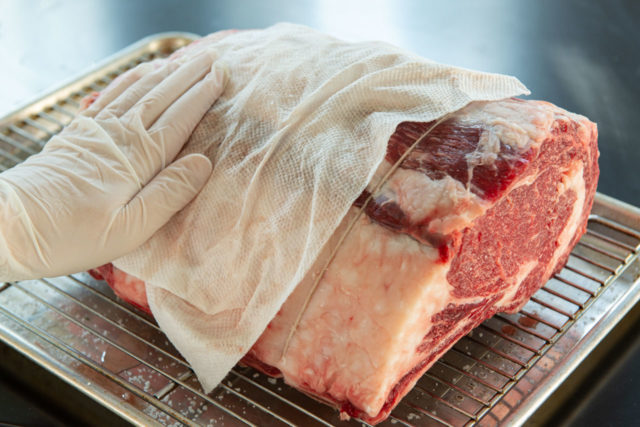
Tie with Twine or Not?
Most grocery stores will sell both the bone-in or boneless rib roast already tied with twine. This helps keep the shape, but more importantly, it helps you maneuver this big cut of meat. I use the twine to turn the rib roast over and around as I’m seasoning.
Should You Trim the Fat?
Personally, I do not trim the fat, nor do I score the fat, because I’m not trying to encourage rendering (we enjoy eating the fatty bits).
Fat also protects the meat as it’s cooking, so I recommend letting people trim on the plate as it suits them. If you desire, you can score the fat for a bit of rendering and a slightly more textured crust.
Keep the Additional Flavors Simple and Traditional
For my prime rib rub, the only flavors I use to accent the beef are fresh rosemary, fresh thyme, and black pepper. Combine them in a small bowl.
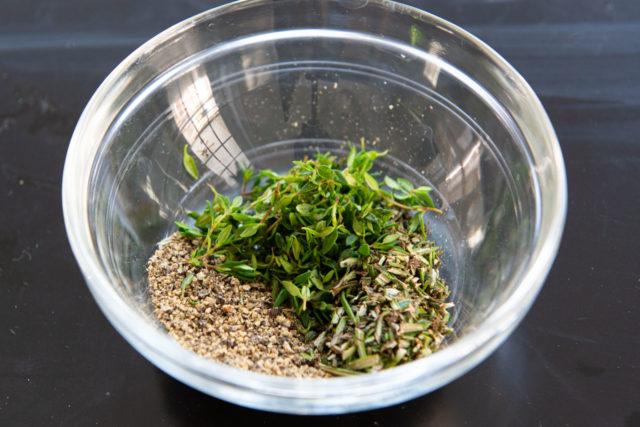
And before someone asks, that’s right, no garlic. I don’t believe garlic has any place here, and I say this as someone who loves garlic. It’s too strong of a flavor here and takes away too much from the beef, and it’s also very prone to burning.
Ghee Is The Best Choice for Rubbing The Exterior
I mix ghee into the rosemary, thyme, and black pepper, then rub it all over the rib roast:
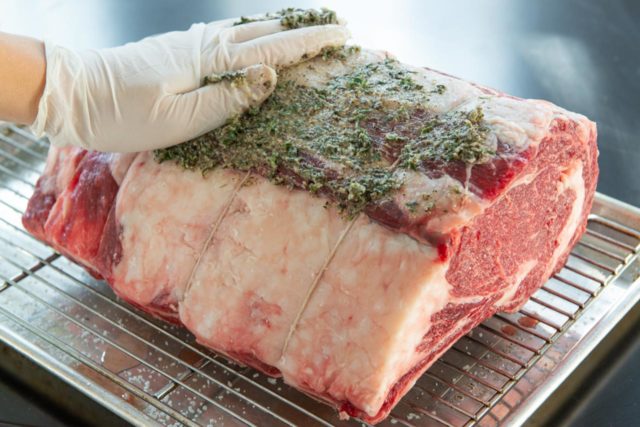
Ghee has a neutral flavor, a very high smoke point, and a great consistency for slathering on the meat and holding all the seasoning evenly in place. Butter and olive oil cannot handle the heat as well.
It’s almost like a paste that’s easy to rub all over the beef:
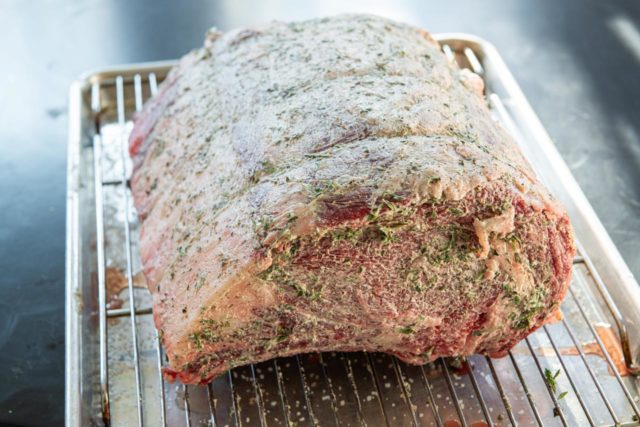
You can see the seasonings here are not so much that it becomes a crust, but just enough for flavoring the beef in a way that I judge to be appropriate for the size. With that said, you are welcome to add more herbs or pepper if you like.
Cook Low and Slow
Place the prime rib in a low temperature 250F oven for several hours, with the fat cap facing up, until it hits an interior temperature of 120F, as measured with a meat thermometer. That will give you medium rare, and it will look like this:
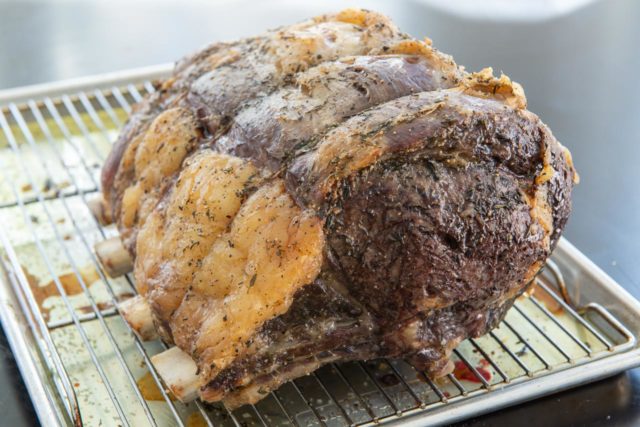
There’s some browning on the outsides, but not a ton. We’re going to need some much hotter direct heat for that, at a much higher oven temperature. But not yet! It’s time to let the roast rest for a bit.
Doneness Guide:
Here are the internal doneness temperatures you will want to check for per your personal preference, for pulling the roast from the oven after the “low temperature cooking period.” The temperature of the meat will rise 5-10 degrees during the rest, and may also increase slightly during browning, so we pull the beef a little underdone.
- 115°F – For rare, cool red center, eventually hitting a target of about 125°F
- 120°F – For medium rare, warm red center, eventually hitting a target of about 130°F
- 130°F – For medium, warm pink center, eventually hitting a target of about 140°F
- 135°F – For medium well, slightly pink center, eventually hitting a target of about 150°F
It’s essential to check the internal temperature with a thermometer at the center of the roast, but the rare mark will usually hit at about 3.5 hours for a 10-lb roast, medium rare at 3.75 hours, and medium at just under 4 hours.
Rest the Beef Now, Not At the End
It’s most common to let meat rest at the very end of cooking, before serving, but here we’re going to do something better. Resting the beef now means we can slice and serve the beef later immediately out of the oven, when the exterior is piping hot, sizzling, and browned.
I rest my bone in prime rib for about 45 minutes, which gives me enough time to get a batch of yorkshire pudding made and get the heat cranked up to 550F for the next stage. But, you can rest anywhere from 30-60 minutes.
There is no need to cover the entire roast with aluminum foil, since we’ll be heating it again right before serving.
Right Before Serving, Blast the Roast with High Heat to Brown It
After the rest period, blast the prime rib in a very hot oven for about 5 minutes until it’s thoroughly browned on the outside:
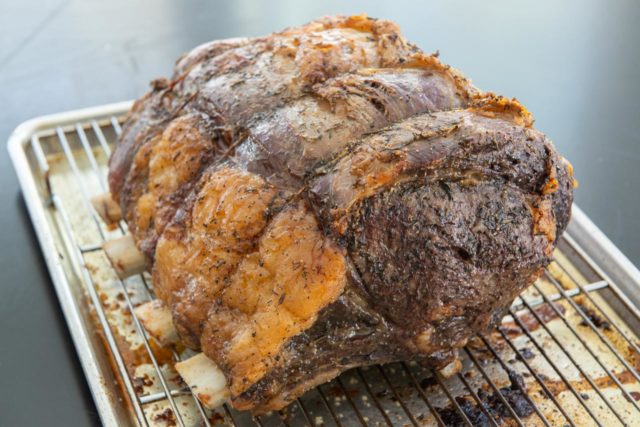
I do this in a 550F preheated oven, and I put it on the convection roast setting so the hot air is really blowing all over the outside.
If your oven goes up to 500 and you don’t have convection, that is okay! You just may need to brown the meat for about 10 minutes instead of 5. I don’t recommend going much longer than 10 minutes though, as you’ll start to cook the interior more and increase the doneness.
Regardless, I recommend standing at the oven door and turning the light on so you can keep your eye on the browning. You’ll notice the outside sputtering a bit like cooking bacon in a skillet, and you may notice some smokiness too. Sometimes I have to turn on the fan and open a window, but it’s brief and it’s worth it.
Serve Immediately After Browning (No Need to Rest Again)
After this quick browning, you can slice and serve the prime rib right away, which is AWESOME because it’ll still be warm inside, and hot, crisp and crusty on the outside.
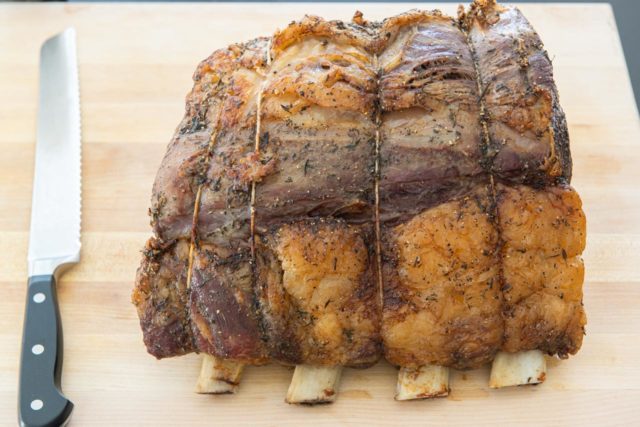
Cut off the twine, and if desired, you can cut right along the bones to remove them. You can see from my pictures that I generally don’t, because I like serving it on the bone. Follow your preference. I use this serrated knife (affiliate), but a sharp chef’s knife works too.
How to Serve It
We are major carnivores in my family, so I personally cut right in between the bones and plate one slice for each person. However, you may also slice off the bones, then cut slices to whatever thickness you’d like.
Potato Gratin is a classic to serve alongside this kingly cut of meat, especially for a holiday meal. I also like Roasted Carrots or Roasted Brussel Sprouts. Neutral starches like Rice Pilaf and Crispy Smashed Potatoes also tend to work nicely as prime rib sides.
I’m pretty traditional with my beef and don’t like to add any sauces, but if you prefer to serve something on the side, try Chimichurri or Romesco.
Holiday appetizers also go great with this meal, like starting with an Antipasto Platter, and hors d’ouerves like Bacon Wrapped Dates, Stuffed Mushroom Caps, or Stuffed Mini Peppers.
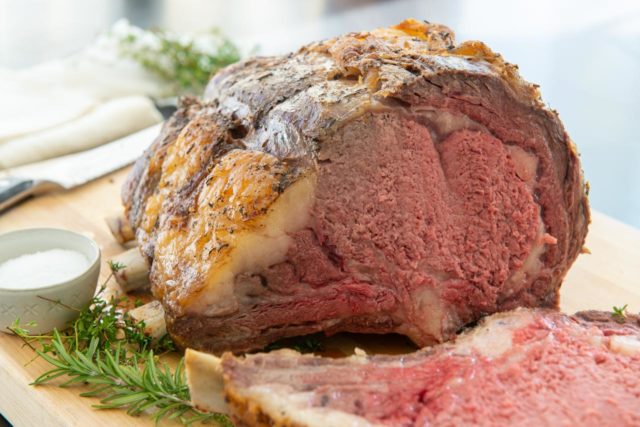
Enjoy the king of holiday roasts! This is so wonderful for a holiday dinner party, and something all home cooks can pull off. Leave any questions you have in the comment section below the recipe card.
Recipe Tips and FAQ:
The temperature of the meat will rise 5-10 degrees during the rest, and may also increase slightly during browning. So for medium rare, what I believe to be optimal for prime rib, I recommend pulling the meat out of the oven at 120F as indicated in the recipe box below. For rare, pull at 115 at about 3.5 hours. For medium, pull at 125F, just under 4 hours.
Beef does not reheat great, and the most reasonable choice is to reheat in the oven (do not use the microwave). Wrap in foil and heat in a 300F oven for about 15 minutes, or until warm enough to enjoy.
The general rule of thumb is to buy 1lb per person. So if you have 10 people, buy a 10lb rib roast.
Yes, beef freezes well. Store in an airtight container in the the freezer for up to 2 months. Thaw in the fridge overnight before reheating.
Did you enjoy the recipe? Please leave a 5-star rating in the recipe card below and/or a review in the comments section further down the page. Or, follow me on Facebook, Instagram or Pinterest!
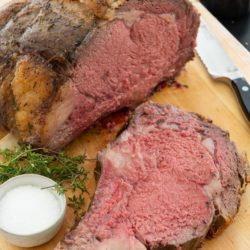
Reverse Sear Prime Rib
Ingredients
For the Prime Rib:
- 10 lb bone-in beef standing rib roast **
- 3 tbsp kosher salt
- 1/4 cup ghee ***
- 1 tbsp finely chopped rosemary
- 1 tbsp fresh thyme leaves
- 1 tbsp freshly cracked black pepper
Compatible Side Dish Recommendations:
Instructions
- One day ahead of time, place a wire rack inside a rimmed half sheet pan. Rub the rib roast all over with the salt, then place on the wire rack. Refrigerate for one day, completely uncovered. You can do this two days in advance if you prefer.
- Two hours before cooking, remove the prime rib from the fridge, and let it stand at room temperature.
- Preheat the oven to 250F.
- In a small bowl, mix together the ghee, rosemary, thyme, and black pepper. Rub all over the rib roast, then place the beef with the bones underneath (see blog post photos if needed).
- Cook the beef in the oven for about 3.5 to 3.75 hours, until the interior measures 120F, which will give you a medium rare interior after carryover cooking. I usually hit 120F at exactly 3.75 hours, but check earlier if you are unsure if your oven is accurate. (For rare, pull at 115F, about 3.5 hours, and for medium, pull at 125F, just under 4 hours).
- Remove the beef from the oven and let it stand at room temperature for at least 30 minutes, and a max of 60 minutes. No need to cover with aluminum foil. During this time, I make yorkshire pudding or other sides in the oven.
- Increase the oven temperature to as high as it will go, ideally 550F, but 500 is okay. Additionally, if you have a convection roast (or convection bake) feature, turn that on as well. When the oven is fully heated, return the rested beef to the oven for between 5 and 10 minutes, until thoroughly browned on the outside. In my oven at 550F with convection roast, 5 minutes is plenty to brown the exterior. I recommend turning the oven light on and watching it closely as it cooks. Do not brown for more than 10 minutes, or you'll start to increase the doneness on the interior.
- The prime rib is now ready to slice and serve right away. There is no need to rest again. If desired, you can remove the bones before slicing by cutting right alongside them. I personally like to serve the pieces bone-in on the plate. Enjoy!
Notes
Nutrition
Nutrition is estimated using a food database and is only intended to be used as a guideline for informational purposes.

42 Comments on “Reverse Sear Prime Rib”
Can the reverse sear method be adjusted to propane BBQ? i.e. start the process on the unheated side of BBQ, remove & let rest, while heating up the entire BBQ and finish as noted in the recipe.
Thank you, sounds wonderful & hope this works on a propane BBQ.
Hi Carolyn! You can use a gas grill for this method! Just keep an eye on the internal temps of your meat and you’ll have no problem. Enjoy!
Thank you for this recipe. I cooked the best 12 pound prime rib of my life! It was a perfect medium rare and tasted delicious. I did use convection for both parts. I had been using a different recipe, but this one was more comprehensive and easier.
Can you do the high heat on the Bbq?
you can, just keep in mind that all the heat will be hitting one side of the meat. you will need to rotate often for it to get all sides
COOK IT IN IRON!
I made this for Christmas dinner this year. Wow! I roasted a 5.5 lb. prime rib roast in a 17″ iron skillet. Using a fancy, fan dangled meat thermometer (digital, haha) I cooked at 250F until 118F in the center. – about 3 hours, 15 minutes and allowed it rest for about 45 minutes.
Meanwhile, the oven was heating to 550F. When heated I put the roast and iron skillet in the oven for 7 minutes — perfect! My rub was only avocado oil, salt & paper, nothing else. Such a beautiful crust and juicy just-over rare roast. I used some leftover for Philly cheesesteak sandwiches!
My Ukrainian wife, who had never tasted a prime rib roast called it, “The Best!” I’m sure we’ll be doing this more often. Thank you for sharing this recipe. The Best.
I have to rave about this reverse searing techniques. My prime rib, even though the internal temp jumped in 45 minutes from 111 degrees to 134 degrees. At first I was worried that it was going to be medium. But it turned out evenly medium rare, a beautiful even color all the way to the edges. I didn’t have to sear it because it had a nice brown color from the fat. Everyone raved about the flavor of the meat.
Last Christmas I used this recipe to roast my first ever prime rib. It turned out absolutely perfect. I was apprehensive to attempt it with such a pricey cut of meat but it was beautiful got rave reviews from the family.
I will be repeating the menu again this year.
I have a 21 lb prime rib how do you long would you cook it for reverse sear
Would like it medium rare
Time is less accurate that’s temperature. Use a multi prong thermometer and place them in several parts of your roast to monitor the temperature, then follow the recipe as written. With a roast that big you will likely have well done in the edges and more rare in the middle. If you don’t want rare, you can always cut the roast and half and prepare two 10 pound versions.
Very nice I have used a horseradish crust with a dijon mustard base which has worked very well very loose foil shield covering during the first phase of cooking and rest for one hour before searing.
Hi! When you cook your prime ribs, did you use convection bake mode or just bake? My oven has two settings – the “convection bake” mode only goes as low as 300F while the “bake” mode goes as low as 200F.
He did not suggest using the convection cycle when roasting at 250 but instead use convection roast for the 500-550 temp at the end
I followed this recipe and the roast was PERFECT! We’ve added a roast to our monthly meal plan. Yummy!
That’s great, Denise! Enjoy!